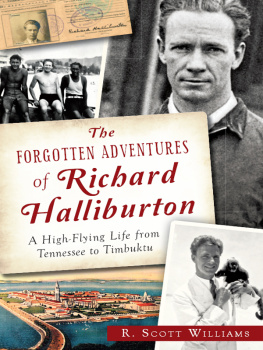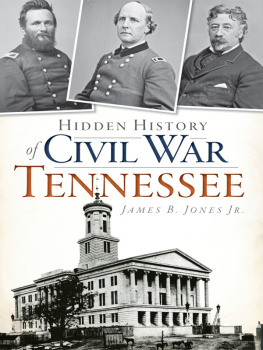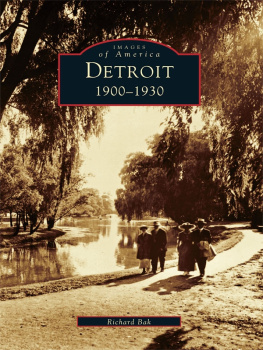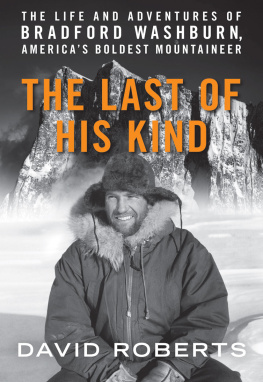
Published by The History Press
Charleston, SC 29403
www.historypress.net
Copyright 2014 by R. Scott Williams
All rights reserved
First published 2014
e-book edition 2014
ISBN 978.1.62585.259.5
Library of Congress Control Number: 2014952246
print edition ISBN 978.1.62619.720.6
Notice: The information in this book is true and complete to the best of our knowledge. It is offered without guarantee on the part of the author or The History Press. The author and The History Press disclaim all liability in connection with the use of this book.
All rights reserved. No part of this book may be reproduced or transmitted in any form whatsoever without prior written permission from the publisher except in the case of brief quotations embodied in critical articles and reviews.
To Michelle, Alex and Liv, the ultimate traveling companions.
Contents
Acknowledgements
First and foremost, thanks go to all those who have written so well about Richard Halliburton in the past, including John Alt, Michael Blankenship, James Cortese, Gerry Max, Chip Deffaa, Jonathan Root, Barbara Schultz, David Schwartz, William Taylor, Guy Townsend and many others. Much credit for this book goes to Kirsten Schofield for the idea and the encouragement.
Wesley Halliburtons dedication to archiving his sons life and accomplishments was invaluable, as was the access, permission and assistance generously granted by Bill Short and the team at the Rhodes College Archives, who have lovingly cared for and continued the collection Wesley Halliburton began. The help and access to the Bobbs-Merrill archives at the Lilly Library at Indiana University was greatly appreciated. Thanks to Sharon Naron at the Hutchison School; Sonia Outlaw-Clark, Lynn Shaw and the Halliburton family in Haywood County, Tennessee; and Rick Mastroianni at the Newseum in Washington, D.C. I am filled with gratitude for my wife and amazing proofer, Michelle, and my daughters, Alex and Liv, who responded with patience and understanding when I was in a library, out of town or locked away in the study.
A special thanks to all those journalists and photographers who shared Richard Halliburtons adventures with the world and all the writers in small towns and big cities who, in their own unique and individual styles, shared reviews of his books and personal appearances with the readers of their community newspapers.
Finally, this book wouldnt be possible without my large Haywood County family, who taught me how to appreciate a good story.
Preface
May 13, 1945
For six years the Pacific Ocean has kept locked in its depths the mystery of the fate that overtook Richard Halliburton, adventurer and writer, who disappeared when his Chinese junk, the Sea Dragon, vanished midway between Hong Kong and San Francisco in March 1939. Speculation on the fate of Halliburton and his crew was revived the other day when the water-logged hull of a small vessel obviously of the same type as Halliburtons was washed ashore at Pacific Beach, near San Diego, Calif. Little remained of the ship, only a flat-bottomed section of heavy timbers, held together with huge brass bolts.
American Weekly
By the time remnants of what possibly was the Sea Dragon (but most likely wasnt) washed up on a beach near San Diego, California, on May 13, 1945, Richard Halliburton and the crew of the Chinese junk had been dead more than six years. During that time, the nation had been focused on fighting the Second World War, so by the time it was suggested a piece of Halliburtons boat had washed ashore, it wasnt the big news it would have been just a decade earlier.
Born in the very first days of the twentieth century, this son of the well-to-do cotton culture of West Tennessee eventually became the most-famous adventure writer of his day. Halliburton inspired millions of readers, young and old alike, to add a little travel and adventure to their lives. And because he lived from 1900 to 1939, his life and career was lived out against the backdrop of a world going through dramatic growth and change. With books on the bestseller lists for years at a time and selling well over a million copies, he made and spent huge sums of money during the Jazz Age and then the Great Depression. As a lecturer and radio personality, millions of individuals personally heard him share his stories in a unique style that was unlike anything anyone had ever heard before.
In his lifetime, Halliburton climbed Mount Olympus in Greece, the Matterhorn in the Swiss Alps and Fujiyama in Japan. He swam the length of the Panama Canal and plunged into the Hellespont in Turkey. He was arrested in Gibraltar, slept on top of the Great Pyramid in Egypt and was the first to photograph both Mount Everest and the Taj Mahal from the air. Halliburton rode a donkey over the Pyrenees and, in homage to Hannibal, rode an elephant across the Alps. He spent time with convicts on Devils Island and a month on the island of Tobago pretending he was Daniel Defoes Robinson Crusoe. Halliburton joined the Foreign Legion, dove seventy feet into a Mayan well of death at Chichen Itza and flew all the way from here toyes, Timbuktuliterally, right across the middle of the Sahara Desert in an airplane he christened the Flying Carpet.
During that time, the articles about his adventures helped sell a lot of newspapers and magazines. When radio was still in its infancy, and before movie theaters sprang up around the country, Americans escaped the boredom of their everyday lives and explored the world around them through ink on paper. With a combined weekly circulation of nine million, Halliburtons syndicated articles appeared in newspapers around the country. While some critics rolled their eyes at his obvious tendency to embellish and an overly enthusiastic and youthful writing style, his fans flocked to hear him speak at public appearances, and teachers applauded him for bringing to life historic events and introducing young readers to the enjoyment that can be found in a good book.
Halliburton was also popular with the rich and famous. His friends included fellow adventurers, journalists, painters, writers, politicians, musicians and entertainers. Known for his unique sense of personal style, good looks and carefree attitude, it was good to have Richard Halliburton at your party. At the height of his career, his fame was equal to well-known personalities like Amelia Earhart, Charles Lindbergh, Charlie Chaplin, Rudolph Valentino and F. Scott Fitzgerald.
If you had been in Kansas City, Missouri, on September 11, 1927, you would have unfolded your copy of the Kansas City Star and read an editors introduction to an article by Richard Halliburton that provides a great summary of the Halliburton image, especially at the beginning of his career:
Richard Halliburton typifies the romantic spirit of youththe desire to do-and-dare, to fulfill dreams regardless of consequences, attempting feats that older heads have declared impossible. Seemingly throwing caution to the winds, he has experienced enough thrills to last a normal man a lifetime. A recent Princeton graduate and reared in most comfortable circumstances, he has lived the life of a vagabond in a tour of the worldbrother to a prince and fellow to a beggar if he be found worthy.

Autographed promotional photograph, 1929. Courtesy of the Rhodes College Archives and Special Collections, Memphis, Tennessee.

Next page







